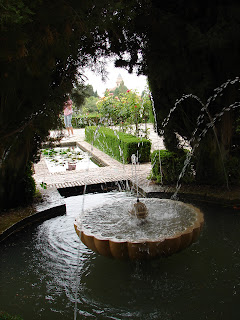Those of you who guessed Alhambra in Granada as the location of our last post, were absolutely right. We took a tour, something we rarely do, because we guessed (rightly, I might add) that we would need some interpretation of what we were seeing. I'm not going to give an involved history of Alhambra except to say that it was built by Moorish sultans who had invaded Spain in back in the ninth century. It's first role was as a fortress and then became more or less, a pleasure palace. It was a hot and tiring tour that lasted three and a half hours. Our guide filled us with information and led us all over the Alhambra site as well as the gardens called "Generalife". (Those of you who have an inkling of Spanish know it's not pronounced like it's spelled.)
For those of you who are wondering, the restrictions on entering the palace stipulated that no flash pictures could be taken, and you had to wear a backpack on your front side, not your back, so as not to inadvertently scrape the pack against the walls and pillars. Everyone seemed to ignore the flash photo rule, but you can see the dudes in the photo above did rearrange their packs.
Our guide pointed out that the Moors built the palace with no exterior decoration; all the ornate work is on the inside. She contrasted that with the later additions by "Christians" which had and ornate exterior and interiors which didn't hold a candle to their Moorish counterparts. Here the Moorish construction is on the left and the Christian construction on the right.
If I understood our guide correctly, this pool is where the sultan's wives and concubines bathed and relaxed. The sultan would look out from the window and point out to one of his castrated employees which woman he'd like as his bed partner for the evening.
During the tour, which was very long, but actually felt quite rushed due to the many things to see, it was very difficult to get a photo without other tourists in the foreground or background. There were other tours in other languages going on as well as free lancers, and independent private tour guides. I've forgotten the number on people who see Alhambra in a given year, but it was impressive.
Washington Irving, the American author is credited with bringing the dilapidated condition of the Alhambra to the world's attention with his book "Tales of the Alhambra". He apparently lived in the Alhambra for awhile in the room where this plaque now resides. I must admit, I knew Irving only as the author of "The Legend of Sleepy Hollow".
What you might imagine being carved stone is actually plaster cast from a wooden carving, placed on the walls and ceilings and painted beautiful colors, most of which are now gone. Nonetheless, it boggles the mind to imagine the amount of work which took place in Alhambra. Also, something tells me very few of the workers made the 'minimum wage'.
Unfortunately, our visit came at a time when the most remarkable of the items inside the Alhambra was under restoration. Here, there normally resides the twelve stone lions, each with a unique face, with a stone fountain perched on their backs. However, we were able to see pictures of the fountain, and the lions that were finished being restored.
The whole idea of a garden and pleasure palace in this hot dry portion of southern Spain is made possible by the waters from melting snows high in the Sierra Nevada just to the south, between Granada and the Costa del Sol. The Sierra Nevada is Europe's second highest mountain range, after the Alps. A system of aqueducts brings water to the Alhambra, and few places inside the palace are without it. Fountains and pools are everywhere.
The water was also used to grow ornamental plants and food as well, all inside the former fortress and safe from the rabble of the ordinary peasants in the village below.
The Spaniards finally managed to kick the Moorish sultans out of Spain, but not until 1492, the year Columbus sailed off to the west to get to the "East". Ferdinand and Isabella, you will recall, used a room in the Alhambra to meet with Columbus and grant him his ships and funds to make his voyage. What came next was a flood of Aztec and Inca gold to Spain, unspeakable crimes against the Native Americans, not to mention the expulsion of the remaining Muslims from Spain and then the Jews and the Inquisition. Oh, my! What a sordid history has Spain.
 Unfortunately, the photo has absolutely nothing to do with Christmas whatsoever but I can't think of a better time to post it. This is my family in August of 1995, in Livingston, Montana. They were all there to help Nancy and I construct our cabin. We're standing just inside of what would become the front door. You can see a couple courses of logs have been put in place and the window and door bucks (frames) stand upright and braced to the plywood floor.
Unfortunately, the photo has absolutely nothing to do with Christmas whatsoever but I can't think of a better time to post it. This is my family in August of 1995, in Livingston, Montana. They were all there to help Nancy and I construct our cabin. We're standing just inside of what would become the front door. You can see a couple courses of logs have been put in place and the window and door bucks (frames) stand upright and braced to the plywood floor.














































